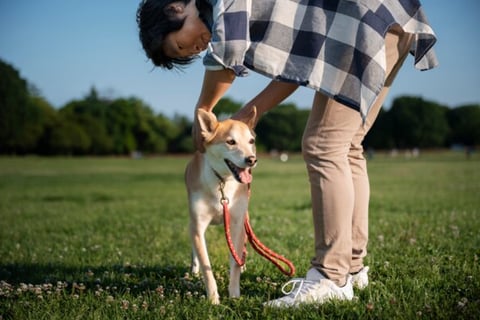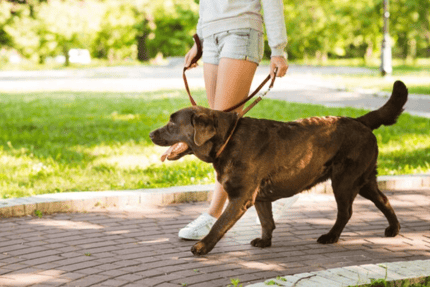
The Pinnacle of Canine Education: Mastering Advanced Dog Training Techniques
In the journey of dog ownership, moving beyond basic commands to advanced training represents a leap towards a deeper companionship and understanding between you and your furry friend. Advanced dog training not only opens up a new world of communication but also significantly enhances the quality of life for both dog and owner. This comprehensive guide aims to dive into the nitty-gritty of advanced techniques, shedding light on the science of canine learning, obedience, specialty skills, behavior modification, and the latest training tools, to solidify the bond you share with your pet.
FAMILY
Grace Isabella
4/27/20244 min read
I. Introduction
Training a dog goes beyond teaching them the basics of sit, stay, or heel. Advanced dog training delves into a higher level of communication and skill that not only satisfies the mental stimulation needs of your dog but also equips them to navigate the complexities of human environments more efficiently. From enhancing obedience to modifying behavior and even engaging in specialized activities, the benefits of advanced training ripple through every aspect of the dog-owner relationship, reinforcing trust, safety, and mutual respect.
Why Are Dog Trainers Furious About This New Training Site? Learn More!
II. Understanding Your Dog's Learning Process
1. The Science of Canine Cognition
Canine cognition explores how dogs perceive their environment, solve problems, and make decisions. Understanding the cognitive abilities of your dog is the cornerstone of effective training, as it allows you to tailor your approach to their individual learning capacity and preferences.
2. Identifying Your Dog's Learning Style
Just like humans, dogs have unique learning styles. Some may respond better to visual cues, while others prefer vocal commands. Observing and respecting these preferences can significantly enhance the training process.
3. The Role of Reinforcement and Punishment
Positive reinforcement, the practice of rewarding desired behavior, is fundamental in dog training. Punishment, on the other hand, should be used sparingly and wisely, as it can sometimes lead to fear or aggression. Balancing these elements is key to a successful training strategy.
Discover the Brain-Boosting Tricks for Your Dog! Access Now!
III. Building on the Basics: Advanced Obedience Training
1. Beyond Sitting and Staying: Teaching Complex Commands
Advanced obedience involves commands that require a higher level of discipline and focus from the dog, such as fetching specific items or navigating obstacle courses on command.
2. Mastering Off-Leash Control
Teaching your dog to respond to commands without the need for a leash opens up a world of freedom for both of you, but it requires trust and meticulous training to ensure safety.
3. Techniques for Improving Focus and Reducing Distractions
Training your dog to maintain focus amidst distractions is critical for both their safety and your peace of mind. Techniques such as gradual exposure and positive reinforcement can be highly effective.
Discover the Brain-Boosting Tricks for Your Dog! Access Now!
IV. Specialty Training Techniques
1. Agility Training Methods for Physical and Mental Fitness
Agility training is not just about physical exercise; it’s a mental workout for your dog that enhances their agility, discipline, and focus.
2. Scent Work and Tracking: Tapping into Natural Instincts
Leveraging your dog's natural instincts, scent work and tracking provide a stimulating and rewarding experience for them, enhancing their mental and olfactory skills.
3. Service and Therapy Dog Training: Steps and Standards
Training a dog for service or therapy roles is a noble endeavor that requires specific techniques and a deep understanding of the dog’s behavior, sensitivities, and capabilities.
Unlock The Secret to Smarter Dogs Today! Click Here!
V. Behavioral Modification Techniques
1. Addressing Aggression and Fear-Based Behaviors
Understanding the root of aggressive or fear-based behaviors is the first step to modifying them. Advanced training techniques focus on trust-building and confidence-boosting exercises.
2. Techniques for Managing Separation Anxiety
Separation anxiety can be distressing for both dogs and owners. Advanced training methods include gradual desensitization and creating positive associations with being alone.
3. Breaking Bad Habits: Effective Strategies and Common Pitfalls
Whether it’s excessive barking or chewing, breaking bad habits requires consistency, patience, and sometimes creative problem-solving skills.
Unlock The Secret to Smarter Dogs Today! Click Here!
VI. Technology and Tools in Advanced Dog Training
1. Innovative Training Aids and How to Use Them
From clickers to electronic collars, the market is full of innovative training aids. Knowing how to use these tools effectively is crucial for advanced training.
2. The Role of Apps and Online Resources in Training
Digital tools and apps can provide support and guidance in your training journey, offering new techniques, tracking progress, and connecting you with a community of fellow trainers.
3. Evaluating the Effectiveness of Training Gadgets
Not all gadgets are created equal. Evaluating their effectiveness in terms of enhancing communication and obedience is key to selecting the right tools for your training needs.
Explore the Official Brain Training for Dogs Website Here
Summary
Advanced dog training is a journey that not only elevates the abilities of your dog but also transforms your relationship into a more harmonious and understanding partnership. Embracing the techniques and tools discussed, along with patience and commitment, will ensure that this journey is rewarding for both you and your canine companion.
FAQs
What is the right age to start advanced dog training?
While foundational training should start as early as possible, advanced training can begin once basic obedience commands are mastered, usually after the first year.
How long does it typically take to see results from advanced training techniques?
The timeframe can vary widely depending on the dog's breed, age, and the complexity of the desired behaviors. Consistency and patience are key.
Can old dogs learn advanced training techniques?
Yes, older dogs can learn new skills. Although they may require more patience and potentially more repetition, age should not be a deterrent to learning.
How can I tell if my dog is ready for advanced training?
A dog that responds well to basic commands and shows eagerness to learn is likely ready for more challenging tasks. Observation and understanding of your dog's capabilities are essential.
What should I do if my dog doesn’t respond to advanced training methods?
Reevaluate the approach, considering your dog's learning style and preferences. Seeking the guidance of a professional dog trainer can also be invaluable.
Embarking on advanced dog training is a commitment to deepening the bond with your pet. It requires patience, understanding, and a willingness to learn. By focusing on these advanced techniques, you’re not just training a dog; you’re nurturing a relationship founded on mutual respect and understanding.
Access Brain Training for Dogs Through the Official Site Here
Connect
info@graciebusiness.com








